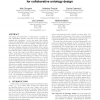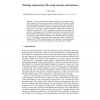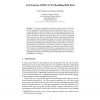197 search results - page 14 / 40 » Representing Phenotypes in OWL |
WWW
2007
ACM
14 years 8 months ago
2007
ACM
The design and maintenance of ontologies is a complex social collaborative activity, and this is true especially for semantic-web ontologies. On the one hand, such activity calls ...
EKAW
2010
Springer
13 years 6 months ago
2010
Springer
A scenario in ontology development and its use is hypothesis testing, such as finding new subconcepts based on the data linked to the ontology. During such experimentation, knowle...
OWLED
2007
13 years 9 months ago
2007
The research community has noted the need to retrieve the instance level of an ontology from bulk data stored in external data sources (e.g., a relational database), in order to de...
JIB
2007
13 years 7 months ago
2007
The creation of quantitative, simulatable, Systems Biology Markup Language (SBML) models that accurately simulate the system under study is a time-intensive manual process that re...
GECCO
2010
Springer
14 years 13 days ago
2010
Springer
HyperNEAT represents a class of neuroevolutionary algorithms that captures some of the power of natural development with a ionally efficient high-level abstraction of development....



